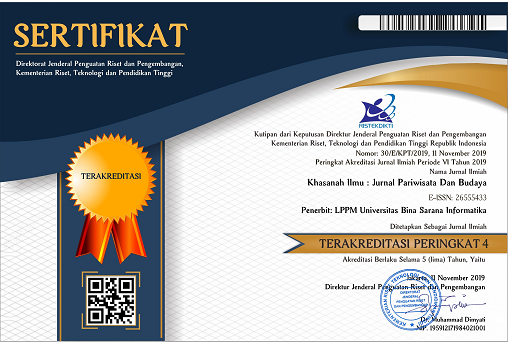Disaster and Destination: Sustainable Tourism Governance in North Bandung Area
Sari
Teks Lengkap:
PDF (English)Referensi
AlBattat, A. R., & MatSom, A. P. (2014). Emergency Planning and Disaster Recovery in Malaysian Hospitality Industry. Procedia - Social and Behavioral Sciences, 144, 45–53. https://doi.org/10.1016/j.sbspro.2014.07.272
Amore, A., & Hall, C. M. (2016). From governance to meta-governance in tourism? Re-incorporating politics, interests and values in the analysis of tourism governance. Tourism Recreation Research, 41(2), 109–122. https://doi.org/10.1080/02508281.2016.1151162
Baggio, R., Scott, N., & Cooper, C. (2010). Improving tourism destination governance: a complexity science approach. Tourism Review, 65(4), 51–60. https://doi.org/10.1108/16605371011093863
Becken, S., & Hughey, K. F. D. (2013). Linking tourism into emergency management structures to enhance disaster risk reduction. Tourism Management, 36, 77–85. https://doi.org/10.1016/j.tourman.2012.11.006
Briere, J., & Elliott, D. (2000). Prevalence, characteristics, and long-term sequelae of natural disaster exposure in the general population. Journal of Traumatic Stress, 13(4), 661–679. https://doi.org/10.1023/A:1007814301369
Brown, N. A., Rovins, J. E., Feldmann-Jensen, S., Orchiston, C., & Johnston, D. (2019). Measuring disaster resilience within the hotel sector: An exploratory survey of Wellington and Hawke’s Bay, New Zealand hotel staff and managers. International Journal of Disaster Risk Reduction, 33, 108–121. https://doi.org/10.1016/j.ijdrr.2018.09.014
Carter, W. N. (2008). Disaster management: A disaster manager’s handbook. Asian Development Bank.
Choi, J., Lee, S., & Jamal, T. (2021). Smart Korea: Governance for smart justice during a global pandemic. Journal of Sustainable Tourism, 29(2–3), 540–549. https://doi.org/10.1080/09669582.2020.1777143
Del Chiappa, G., & Baggio, R. (2015). Knowledge transfer in smart tourism destinations: Analyzing the effects of a network structure. Journal of Destination Marketing and Management, 4(3), 145–150. https://doi.org/10.1016/j.jdmm.2015.02.001
Drabek, T. (1995). Disaster Responses within the Tourist Industry. International Journal of Mass Emergencies and Disasters, 13(1), 7–23.
Ervina, E., Wulung, S. S. R. P., Octaviany, V., & Octivany, V. (2020). Tourist Perception of Visitor Management Strategy in North Bandung Protected Area. Journal of Business on Hospitality and Tourism, 6(2), 303. https://doi.org/10.22334/jbhost.v6i2.235
Faulkner, B., & Vikulov, S. (2001). Katherine, washed out one day, back on track the next: A post-mortem of a tourism disaster. Tourism Management, 22(4), 331–344. https://doi.org/10.1016/S0261-5177(00)00069-8
Gössling, S., & Peeters, P. (2015). Assessing tourism’s global environmental impact 1900–2050. Journal of Sustainable Tourism, 23(5), 639–659. https://doi.org/10.1080/09669582.2015.1008500
Gunn, C. A., & Var, T. (2002). Tourism planning: basics, concepts, cases (4th ed). Routledge.
Higgins-Desbiolles, F. (2020). Socialising tourism for social and ecological justice after COVID-19. Tourism Geographies, 22(3), 610–623. https://doi.org/10.1080/14616688.2020.1757748
Hoque, A., Afrin, F., & Hasanat, M. W. (2020). The Effect of Coronavirus (COVID-19) in the Tourism Industry in China Marketing View project Measuring Revisit Intention of Tourists’ for Destination Bangladesh View project. Asian Journal of Multidisciplinary Studies, 3(1). https://www.researchgate.net/publication/340309682
Kementerian Pariwisata. (2017). Buku Pedoman Pemberian Penghargaan bagi Destinasi Pariwisata Berkelanjutan. Kementerian Pariwisata.
Laws, E. (2011). Tourist destination governance: Practice, theory and issues. Cabi.
Ma, H., Chiu, Y. H., Tian, X., Zhang, J., & Guo, Q. (2020). Safety or travel: Which is more important? The impact of disaster events on Tourism. Sustainability (Switzerland), 12(7). https://doi.org/10.3390/su12073038
Manyena, S. B. (2006). The concept of resilience revisited. In Disasters (Vol. 30, Issue 4, pp. 434–450). https://doi.org/10.1111/j.0361-3666.2006.00331.x
Murphy, P. E., & Bayley, R. (1989). Tourism and disaster planning. Geographical Review, 79(1), 36–46. https://doi.org/10.2307/215681
Nguyen, D., Imamura, F., & Iuchi, K. (2016). Disaster management in coastal tourism destinations: The case for transactive planning and social learning. International Review for Spatial Planning and Sustainable Development, 4(2), 3–17. https://doi.org/10.14246/irspsd.4.2_3
Novianti, E., Endayana, C., Lusiana, E., Wulung, S. R. P., & Desiana, R. (2021). Persuasive Communication: Disaster Literacy in Tourism Areas. Review of International Geographical Education Online2, 11(4), 1203–1210. https://doi.org/10.33403/rigeo.8006836
O’Brien, G., O’Keefe, P., Rose, J., & Wisner, B. (2006). Climate change and disaster management. Disasters, 30(1), 64–80. https://doi.org/10.1111/j.1467-9523.2006.00307.x
Perrow, C. (2011). The next catastrophe: Reducing Our Vulnerabilities to Natural, Industrial, and Terrorist Disasters. Princeton University Press.
Rahmafitria, F., & Misran. (2018). Disaster risk and travel decision of Middle Eastern tourists to natural destination in Indonesia. IOP Conference Series: Earth and Environmental Science, 179(1), 12006. https://doi.org/10.1088/1755-1315/179/1/012006
Rindrasih, E. (2015). Tourism and Disaster: The Review of Government Policy toward the Impact of Natural Disaster on {Tourism Industry Performance. ASEAN Journal on Hospitality and Tourism, 14(1), 23–34.
Rindrasih, E., Witte, P., Spit, T., & Zoomers, A. (2019). Tourism and Disasters: Impact of Disaster Events on Tourism Development in Indonesia 1998-2016 and Structural Approach Policy Responses. Journal of Service Science and Management, 12(02), 93–115. https://doi.org/10.4236/jssm.2019.122006
Ritchie, B. (2008). Tourism Disaster Planning and Management: From Response and Recovery to Reduction and Readiness. Current Issues in Tourism, 11(4), 315–348. https://doi.org/10.1080/13683500802140372
Ritchie, B. W., & Jiang, Y. (2019). A review of research on tourism risk, crisis and disaster management: Launching the annals of tourism research curated collection on tourism risk, crisis and disaster management. Annals of Tourism Research, 79. https://doi.org/10.1016/j.annals.2019.102812
Rittichainuwat, B., Nelson, R., & Rahmafitria, F. (2018). Applying the perceived probability of risk and bias toward optimism: Implications for travel decisions in the face of natural disasters. Tourism Management, 66, 221–232. https://doi.org/10.1016/j.tourman.2017.09.013
Robina-Ramírez, R., Sánchez, M. S. O., Jiménez-Naranjo, H. V., & Castro-Serrano, J. (2021). Tourism governance during the COVID-19 pandemic crisis: A proposal for a sustainable model to restore the tourism industry. Environment, Development and Sustainability. https://doi.org/10.1007/s10668-021-01707-3
Teguh, F. (2015). Tata kelola destinasi membangun ekosistem pariwisata. Gadjah Mada University Press.
Vargas, A. (2020). Covid-19 crisis: a new model of tourism governance for a new time. Worldwide Hospitality and Tourism Themes, 12(6), 691–699. https://doi.org/10.1108/WHATT-07-2020-0066
Wahyuningtyas, N., Tanjung, A., Kodir, A., & Wijanarko, H. (2020). Management of Tourism Areas Based on Disaster Mitigation (Case Study of Senggigi Beach). IOP Conference Series: Earth and Environmental Science, 412(1), 12015. https://doi.org/10.1088/1755-1315/412/1/012015
Wulung, S. R. P., & Abdullah, C. U. (2020). Upaya Mitigasi Pasca Tsunami Di Destinasi Pariwisata. Media Bina Ilmiah, 14(7), 2883–2894.
Wulung, S. R. P., Abdullah, C. U., & Ervina, E. (2019). Post-Disaster Management in Tourism Destination: A Case of Tanjung Lesung, Indonesia. Proceedings The 2019 International Conference on Culture, Technology, and Tourism (CTT), 1, 14. http://journal.prasetiyamulya.ac.id/journal/index.php/Proceedings/article/view/344
Wulung, S. R. P., & Brahmantyo, B. (2019). Geotourism Reinterpretation towards Natural Tourist Attractions in Bandung Basin, West Java, Indonesia. 3rd International Seminar on …. https://doi.org/10.2991/isot-18.2019.62
Query date: 2020-07-02 16:10:42
DOI: https://doi.org/10.31294/khi.v16i1.21377











